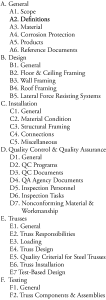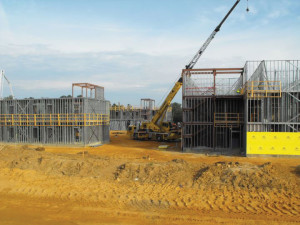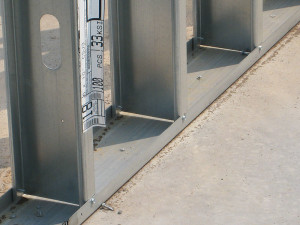“The whole is greater than the sum of its parts” is an often-used phrase. Commonly attributed to Aristotle, these words ring especially true when examining the recent evolution of the AISI standards. Ten years ago, the AISI standards were compartmentalized into discrete packages on such topics as: general provisions, header design, truss design, structural wall stud design, floor and roof system design, and lateral force resisting system design.
Today, the landscape is much different for cold-formed steel light frame construction. Over the past several years, the AISI Committee on Framing Standards (COFS), with oversight from the AISI Standards Council, has worked hard to develop a “whole” document to cover the structural design of cold-formed steel framing. Released at the end of 2015, AISI S240, North American Standard for Cold-Formed Steel Structural Framing, represents more than the sum of the individual parts. In fact, one aspect is the brand-new chapter addressing the topic of quality control (QC) and quality assurance (QA). This article explores the new standard, with special focus on these new QC and QA provisions.
New Provisions
With the ever increasing size and height of cold-formed steel light frame buildings along with the consolidation of the AISI standards into the new AISI S240, the AISI Standards Council seized the opportunity to institute minimum QC and QA requirements. These new requirements are contained within AISI S240, Chapter D. Table 1 shows the outline for AISI S240.
In 2013, the AISI Standards Council assigned the development of the new QC and QA provisions for cold-formed steel structural framing to the Standard Practices Subcommittee of the Committee on Framing Standards (COFS). Shortly afterwards, an AISI task group was formed and efforts to write the provisions began in earnest. Rather than reinvent the wheel, the AISI provisions were patterned after similar requirements adopted by the American Institute for Steel Construction in the Specification for Structural Steel Buildings (AISC 360-10 Chapter N) and the Steel Deck Institute in the Standard for Quality Control and Quality Assurance for Installation of Steel Deck (SDI QA/QC-2011). The AISI task group also considered recommendations from a recent ICC code change proposal for the International Building Code (IBC) authored by the National Council of Structural Engineers Associations (NCSEA) – ICC S145-12. While the proposal was not approved for the 2015 edition of the IBC, many of the requirements seemed relevant given today’s larger cold-formed steel framed buildings.
Similar to the AISC and SDI standards, the AISI S240 Chapter D provisions define key terms, establish responsibilities, and set requirements for the following: QC programs, QC and QA documents, inspection personnel, inspection tasks, and nonconforming material and workmanship.
AISI S240 defines the two key terms as:
Quality Control (QC): Controls and inspections implemented by the component manufacturer or installer to confirm that the material provided and work performed meet the requirements of the approved construction documents and referenced standards
Quality Assurance (QA): Monitoring and inspection tasks performed by a registered design professional, firm or approved agency other than the component manufacturer or installer to ensure that the material provided and work performed by the component manufacturer and installer meet the requirements of the approved construction documents and referenced standards. QA includes those tasks designated “special inspection” by the applicable building code.
Quality control is the responsibility of each contractor, subcontractor and installer on the project for their respective scope of work. Depending on requirements specified by the local jurisdiction, the model building code, or the contract between the contractor and the owner or registered design professionals, the general contractor may also be responsible for hiring the QA inspector for the project.
AISI S240 Chapter D establishes the minimum QC and QA requirements for material control and installation for cold-formed steel light-frame construction. In the standard, material control refers to the general oversight of the materials by the component manufacturer and installer and involves procedures for storage, release and movement of materials. Throughout the manufacturing and construction processes, materials must be identified and protected from degradation. Nonconforming items also need to be identified and segregated. Additionally, minimum observation and inspection tasks deemed necessary to ensure quality construction are spelled out within the chapter. However, the scope states that the QC and QA provisions do not apply to the following: cold-formed steel nonstructural members; the manufacture of cold-formed steel structural members, connectors or hold-downs other than material control; the manufacture of mechanical fasteners or welding consumables; or QC or QA for other materials and methods of construction.
Similar to the AISC and SDI QC and QA provisions, AISI S240 Chapter D provides easy to use tables that itemize the specific QC and QA tasks to be performed prior to, during and after such activities as: material verification prior to assembly and installation; welding; mechanical fastening; and special provisions for lateral force resisting systems. As an example, Table 2 shows Table D6.5-1 from AISI S240.
Within the AISI S240 Chapter D tables, QC and QA tasks are prescribed as “observe”, “perform”, or “not required”. While different than the IBC Chapter 17 requirements for special inspection, this approach is similar to the AISC and the SDI QC and QA requirements. Observe means that items are to be inspected on an intermittent basis, and operations that do not interfere with the ability to perform inspection of these items need not be delayed pending these inspections. The frequency of observations must be adequate to confirm that the work has been performed in accordance with the approved construction documents. On the other hand, perform indicates critical tasks that are to be executed prior to final acceptance for each item or element. For the listed tasks, the inspector is required to prepare reports or other written documentation indicating whether the work has been performed in accordance with the approved construction documents.
Example Application
As illustrated in Figure 1, a general contractor is building a small, 3-story cold-formed steel framed multi-family residential building (Risk Category II) located in an area with low basic wind speeds (< 115 mph, per ASCE 7-10) and falling into seismic design category B (per ASCE 7-10). The primary structure is composed of cold-formed steel framed walls supporting cold-formed steel framed floor joists and roof trusses. The lateral stability of the structure is provided by cold-formed steel framed strap braced walls.
As outlined above, the contractor is designated as the “installer” in this example and is responsible for the QC portion of the requirements of AISI S240, Chapter D. In this project, there is a subcontractor specifically assigned for construction of the cold-formed steel framing, and the general contractor has delegated the QC responsibility to them. Based on the contract, the owner has taken responsibility for hiring the QA inspector for all aspects of the work and has specified the frequency of observations needed to confirm that the work has been performed in accordance with the approved documents.
According to AISI S240 Chapter D, all wall and floor framing material must be verified by both the QC and QA inspector both before and after installation. This is to ensure that the material supplied and installed is the correct product and in acceptable condition. Mechanical fastening must also be reviewed by both inspectors, but only on a periodic basis prior to installation. After installation, all connections must be reviewed and verified for conformance with the approved construction documents.
For this example building, the strap braced walls are connected by mechanical fasteners and post-installed concrete anchors. Per AISI S240, Section D6.9, special documentation for welding and fastener procedures is required. Lateral force resisting systems must be continuously reviewed during installation. Screw connections in shear walls must only be periodically reviewed during and after installation, but each and every post-installed concrete anchor must be verified after installation.
The roof trusses in this example building are most likely pre-engineered and pre-manufactured, meaning that the component manufacturer performs their own in-house QC during the fabrication of these assemblies. However, the installed placement, anchorage, bridging and bracing, as well as any mechanisms needed for transfer of lateral forces between the roof and walls systems, must be inspected during installation.
If any of the inspections uncover materials or workmanship that is not in conformance with the approved construction documents, then the building may be subject to additional inspections. For instance, Figure 2 shows a gap between the structural stud and track that exceeds the limits of AISI S240 Chapter C. This nonconformance must be brought to the immediate attention of the contractor and the installer, and brought into conformance or made suitable for its intended purpose as determined by the registered design professional.
Why “Quality Control and Quality Assurance” instead of “Special Inspection”?
The IBC currently specifies “Special Inspections” in Chapter 17; yet, the steel industry, as a whole, has embraced the concept of “Quality Control and Quality Assurance” – why the break with convention?
The development of QC and QA for the steel industry can be traced back to the publication of FEMA 353, Recommended Specifications and Quality Assurance Guidelines for Steel Moment Frame Construction for Seismic Applications, as part of the Program to Reduce the Earthquake Hazards of Steel Moment-Frame Structures (SAC Joint Venture) in 2000. At the time, it was noted that there were significant variations in the application of special inspection to structural steel moment frames. Over the course of the project, it became clear that achieving good quality construction in conformance with the approved construction documents involved a number of parties, including, but not limited to, fabricators, erectors and engineers. So, the report recommended using the terms “quality control” and “quality assurance” to begin delineating the different roles needed in the process. Those roles then became codified in the 2005 edition of AISC 341, Seismic Provisions for Structural Steel Buildings, which was first adopted by the 2006 edition of the IBC.
From there, the AISC Committee on Specification (COS) chose to develop a coordinated and complete set of QC/QA provisions for structural steel in AISC 360-10, Chapter N. As Charlie Carter, Vice President and Chief Structural Engineer with the American Institute of Steel Construction stated in his presentation on “Quality Control and Assurance in AISC 360-10” at the 2010 North American Steel Construction Conference, “we were either [going to be] the first buffalo to the cliff or the pioneers.”
Why “Observe” and “Perform”?
The IBC currently uses “periodic” and “continuous” to describe the frequency of special inspections in Chapter 17; yet the steel industry, as a whole, uses “observe” and “perform” with explicit lists of tasks to describe the needed inspections – why?
When developing the QC/QA provisions for AISC 341-05, the AISC COS found that the terms “periodic” and “continuous” were vague and often led to different interpretations, depending upon the individual parties involved. Consequently, the structural steel industry settled on the term “observe” to describe inspections that are done intermittently. Their frequency is dependent upon the specific task, the particular needs of the project, and the contractor involved. The term “perform” is meant to apply to critical inspections that must be done prior to final acceptance of the item. Ultimately, the steel industry believes that this more uniform approach to inspection leads to better quality construction.
AISI Committee Process
The efforts of AISI in construction standards development began in the 1930s with sponsored research at Cornell University, which culminated in the publication of the first Specification for the Design of Light Gage Steel Structural Members in 1946. AISI has continued its investments in cold-formed steel research and development working towards continuous improvement of the industry standards – the latest being the completion of AISI S100-12, the North American Specification for the Design of Cold-Formed Steel Structural Members, 2012 Edition by the Committee on Specifications (COS).
In 1997, AISI formed the Committee on Framing Standards (COFS). This was done because of the increased interest in the use of cold-formed steel for residential and light commercial framing and the concern that there were a number of design issues that were not adequately addressed for this emerging market.
The COFS is organized under the same ANSI-approved operating procedures that govern the COS. These procedures ensure balance between producer, user and general interest categories on the committees; establish the voting rules, including the resolution of negatives; require public review of draft standards; and allow for formal interpretations and appeals. The consensus process is overseen by the AISI Standards Council which works to ensure that it remains open, balanced, and transparent. Voting on the standards is by letter ballot. AISI serves as the Secretariat for the COS and COFS.
Conclusions
Today’s cold-formed steel light frame buildings are being built taller and larger than ever before. To keep up with the ever expanding market, the AISI Standards Council requested that the COFS develop a comprehensive structural standard with QC and QA provisions similar to those developed and maintained by both AISC and SDI. The new AISI S240, Chapter D was available for adoption and use in December 2015.
To facilitate their use, the QC and QA provisions for cold-formed steel structural framing, as well as the rest of the suite of AISI design and installation standards, are available as a free electronic download at www.aisistandards.org.▪




